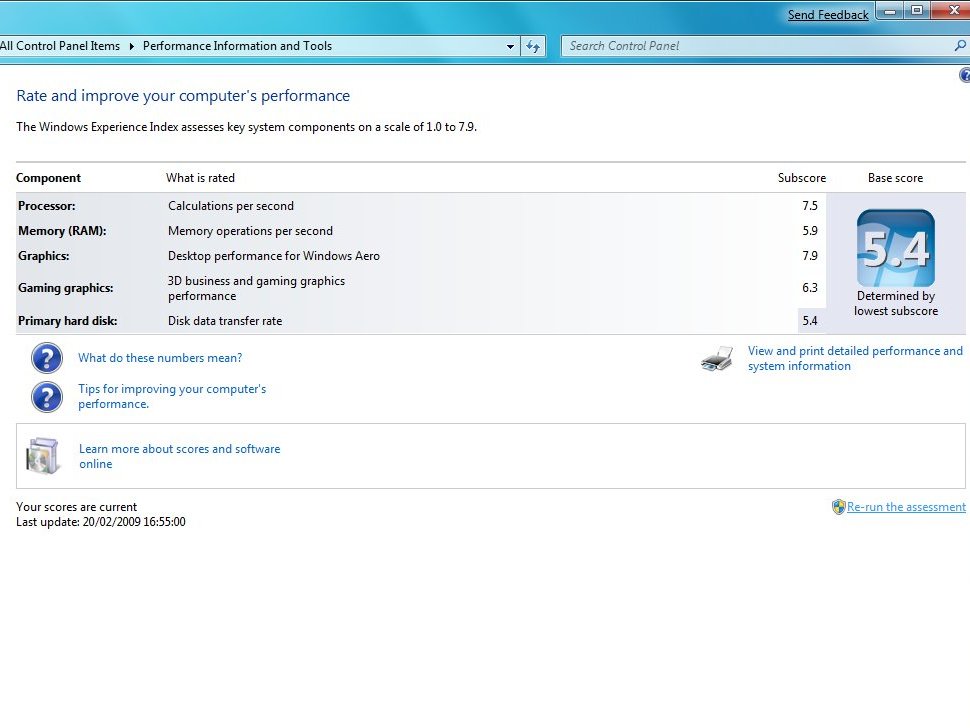
Benchmarks are controversial things. If it's not the users complaining about the scores not being correct then it's hardware manufacturers trying to insinuate it's not optimised correctly and can't possibly be showing the hardware off in a real-world best-light way.
So when Microsoft integrated the Windows Experience Index (WEI) into Windows Vista we hoped it knew what it was letting itself in for. Let's face it, your sole worth as a human being is entirely encapsulated in a benchmark score, and by Jove you're going to let people know about it. As long as that doesn't involve more than a forum post.
Windows 7 includes a realigned WEI score. And no sooner was the beta pushed out into the world than the complaints about the new WEI started rolling in. Part of this is Microsoft's own fault, as it tries to give the impression that the index - which now goes up to 7.9 from the previous high of 5.9 - has remained unchanged with the new score ranges sitting atop of the old.
This simply isn't the case; some of the evaluations are certainly new. To be fair to Microsoft, these changes are implemented for the good of the user, but it could be interpreted that it's shifting the goalposts slightly.
How you'll be able to get 7.9
Still, we thought hitting 7.9 would be no problem at all. We have a state-of-the-art Intel Core i7 test rig in the TechRadar lab. It packs a quad-core Core i7 Extreme Edition, 3GB of triple channel 1,333MHz DDR3 memory and an ATI Radeon 4870 X2. So we were somewhat taken aback when the processor score came back as 7.5, the graphics a pedestrian 6.3 and the memory a mere 5.9.
Obviously Windows 7 is a forward looking OS and we can expect the first 6 and 8-core consumer processors to be available by the time it really gets going in early 2010. As a 3.2GHz quad-core processor only makes 7.5 we'd expect you'll need a fast 6-core to at least to make the magic 7.9. Taking the Core i7 to 4GHz did reach 7.9 though. We found an Athlon X2 5200+ scored 5.5, while a decent Core 2 Duo clocked at 2.70GHz makes it into the low 6's.
Get daily insight, inspiration and deals in your inbox
Sign up for breaking news, reviews, opinion, top tech deals, and more.
Equally amazing was the score for the Radeon 4870 X2, this is a top-of-the-range Crossfire gaming card and it only just makes it into the 6's. We also tried a GeForce X285 to receive a mere 6.0. More encouragingly both score 7.9 in the Aero test.
Microsoft has also overhauled the 2D and 3D test for Windows 7.0, there are enhanced DirectX 9 and 10 3D tests along with more media handling.
But with these scores, we can't even see an existing quad SLI or Crossfire rig scoring much past the low 7's. Considering the next generation Nvidia and AMD graphics technology which will be supporting DirectX 11 features are due out towards the end of 2009 this is a strong indication that to get 7.9 is going to require a high-end multi-GPU DirectX 11 system.
What memory and storage will you need?
The memory is another stunning factor, we tested the fastest memory available running over a triple channel. But the WEI is well known for imposing artificial limits on certain scores, memory being a particularly limiting one. Essentially 5.9 is the highest you can score with less than 4GB of memory and from what we can evaluate, a stunning 8GB will be required to score over 7. And even so it's going to have to be fast memory to make the grade.
That leaves one last area - and currently it's one that we can't see anyone managing to touch any time soon. Hard drive performance was always a difficult one: even with the last WEI, you had to opt for a Western Digital 10,000RPM Raptor, a RAID solution or be very picky with your main drive selection to hit the magical 5.9.
With the new WEI Microsoft has rightly taken the chance to re-evaluate how it measures drive performance and has adjusted the test to favour a drive's ability to handle high amounts of read/write requests with a low latency, rather than raw I/O transfer speed - the previous test.
Even with two RAID0 SSD drives, we didn't achieve anything higher than 6.5. And frankly that's not the sort of solution we expect anyone to be regularly running even by the start of 2010.
So what does it all mean? Well, the way the Windows 7 WEI currently stands means it'll be tough making the magical 7.9 score. Processor, yes. Graphics, possibly, Memory, yes. Hard drive, doubtful. But we've no doubt that to hit that we'll have to run an eight-core processor, dual DirectX 11 high-end GPU set-up, 8GB of 1066MHz DDR3 memory and RAID solid-state hard drives. While that sounds fantastical now, it's going to be brilliant when it happens.